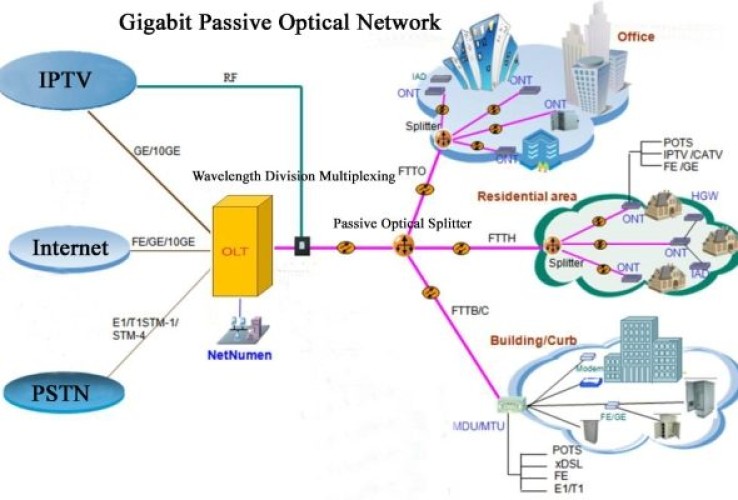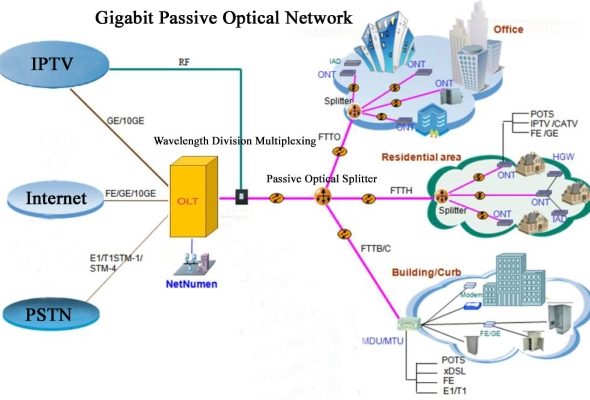
Is GPON The Bee's Knees For Broadband?
Is GPON the bee's knees for broadband? In the world of high-speed internet, finding the right technology is no easy task. But fear not, young reader! Today, we'll dive into the exciting world of GPON and explore whether it's the ultimate solution for your broadband needs.
Picture this: you're streaming your favorite show, in the middle of an epic gaming session, or just trying to get some work done. Suddenly, your internet slows down to a snail's pace, leaving you frustrated and longing for a better connection. That's where GPON comes in.
GPON, or Gigabit Passive Optical Network, is a cutting-edge technology that delivers lightning-fast internet speeds. It uses fiber-optic cables to transmit data, allowing for a more reliable and efficient connection. But is it really as amazing as it sounds? Let's find out!
By the end of this article, you'll have a clear understanding of what GPON is, how it works, and whether it's the bee's knees for your broadband. So buckle up, my friend, and get ready to embark on a journey into the world of high-speed internet. Let's uncover the truth about GPON!

Is GPON the Bee's Knees for Broadband?
In today's digital age, fast and reliable internet is a necessity for both work and play. When it comes to broadband technology, GPON (Gigabit Passive Optical Network) has been making waves in the industry. But is GPON really the bee's knees when it comes to broadband? In this article, we will delve into the world of GPON, explore its benefits and drawbacks, and see how it compares to other broadband technologies.
What is GPON?
GPON, or Gigabit Passive Optical Network, is a fiber-optic telecommunications network that uses passive splitters to split the fiber optic signal, allowing it to be shared by multiple users. It provides high-speed internet access up to 2.5 Gbps (gigabits per second) for both residential and business users.
One of the key advantages of GPON is its ability to transmit data over long distances without any significant loss in speed. It uses advanced modulation techniques and error-correction algorithms to ensure reliable and high-quality data transmission. This makes it an ideal choice for areas where laying traditional copper cables is impractical or cost-prohibitive.
In addition to internet access, GPON can also support other services such as voice over IP (VoIP), IPTV (Internet Protocol Television), and video conferencing. Its high bandwidth and low latency make it suitable for bandwidth-intensive applications and services.
The Benefits of GPON
GPON offers several advantages over traditional broadband technologies. One of the main benefits is its incredible speed. With download speeds of up to 2.5 Gbps, GPON provides a seamless browsing and streaming experience, even when multiple devices are connected to the network.
Another advantage of GPON is its ability to support a large number of users. Unlike some other broadband technologies that experience significant speed degradation as more users connect to the network, GPON can handle a high number of concurrent users without compromising on speed or quality.
GPON is also highly scalable, meaning it can easily accommodate future growth and increased demand for bandwidth. As the demand for internet services continues to grow, GPON networks can be expanded to meet the needs of users without requiring extensive infrastructure upgrades.
GPON vs. Other Broadband Technologies
While GPON has many advantages, it's important to consider how it compares to other broadband technologies. One of the main competitors to GPON is xDSL (Digital Subscriber Line), which uses copper wires to transmit data. While xDSL is widely available and relatively inexpensive, it has limited bandwidth compared to GPON and is susceptible to speed degradation over long distances.
Cable internet is another popular broadband option. It uses coaxial cables to deliver internet access and can provide high speeds. However, cable internet speeds can be affected by the number of users on the same connection, resulting in decreased speeds during peak usage times.
Fiber-optic broadband, which includes GPON, is considered the gold standard in terms of speed and reliability. Fiber-optic cables can transmit data at the speed of light and are not susceptible to electromagnetic interference like copper cables. This means that GPON can provide faster and more stable internet than both xDSL and cable internet.
GPON Installation and Tips
If you're considering getting GPON broadband installed in your home or office, here are some tips to keep in mind:
- Contact your internet service provider to see if GPON is available in your area.
- Consider the number of devices and users that will be connected to the network to ensure you choose the appropriate GPON package.
- Find out if the GPON installation requires any additional equipment, such as an optical network terminal (ONT).
- Research different internet service providers to compare pricing, speeds, and customer reviews.
- Consider any additional services that you may need, such as bundled TV or telephone services.
Conclusion
GPON is undoubtedly an impressive broadband technology that offers high-speed internet access, scalability, and reliability. It outperforms other broadband technologies like xDSL and cable internet in terms of speed and stability. If you're looking for a future-proof solution that can handle the demands of today and tomorrow, GPON is definitely worth considering.
Key Takeaways: Is GPON the bee's knees for broadband?
- GPON stands for Gigabit Passive Optical Network.
- GPON is a cutting-edge technology that allows for high-speed broadband connections.
- It uses fiber optics to transmit data, offering faster and more reliable internet.
- GPON is the bee's knees for broadband because it delivers high bandwidth and low latency.
- With GPON, you can enjoy seamless streaming, online gaming, and faster downloads.
Frequently Asked Questions
As technology advances, the demand for fast and reliable internet connections is on the rise. GPON, or Gigabit Passive Optical Network, is one such solution that has gained popularity in the broadband industry. In this section, we will address some common questions and shed light on whether GPON is the ultimate solution for broadband.
1. How does GPON enhance broadband connectivity?
GPON uses fiber optic cables to transmit data, resulting in significantly faster and more reliable internet connections. This technology allows for higher bandwidth capacity, enabling faster download and upload speeds. Additionally, the passive nature of GPON eliminates the need for active equipment at every node, reducing operational costs and improving network efficiency. Overall, GPON enhances broadband connectivity by delivering faster speeds and improving network performance.
However, it is important to note that GPON's performance is subject to various factors such as network congestion, distance from the central office, and individual service provider limitations. While GPON greatly improves broadband connectivity, other factors also play a role in the overall internet experience.
2. Are there any limitations to GPON technology?
Like any other technology, GPON does have its limitations. One of the limitations of GPON is the distance limitation. Fiber optic cables have a maximum transmission distance, and when that limit is exceeded, signal degradation can occur. This means that users located far away from the central office may experience slower speeds compared to those closer to the source.
Another limitation is that GPON is a shared network, where multiple users share the same bandwidth. During times of high network congestion, such as peak hours, the available bandwidth is divided among more users, potentially resulting in reduced speeds for individual users. However, service providers often manage this by implementing fair usage policies to ensure a satisfactory experience for all users.
3. Is GPON suitable for residential broadband?
Yes, GPON is widely used for residential broadband due to its ability to provide high-speed internet connections. Its fiber optic technology ensures faster and more reliable internet speeds compared to traditional copper-based solutions. With GPON, households can enjoy seamless video streaming, online gaming, and fast file downloads. Additionally, the scalability of GPON allows service providers to easily upgrade and expand their network to meet the increasing demands of residential customers.
However, it is important to consider factors such as availability, cost, and individual requirements when choosing a broadband solution. GPON may not be available in all areas or may incur additional installation costs. It is advisable to check with local service providers to determine the availability and suitability of GPON for residential broadband in your area.
4. What are the advantages of GPON over traditional broadband solutions?
One of the key advantages of GPON over traditional broadband solutions is its higher bandwidth capacity. GPON can deliver speeds of up to 2.5Gbps, whereas traditional solutions like DSL or cable internet often have lower maximum speeds. This allows for faster downloads, smoother streaming, and improved overall internet performance.
Additionally, GPON's use of fiber optic cables provides more reliable connectivity compared to copper-based solutions. Fiber optic cables are less prone to interference and can transmit data over longer distances without signal degradation. This ensures consistent speeds and reduces the chances of internet disruptions due to external factors.
5. What are the potential future developments for GPON technology?
The broadband industry is constantly evolving, and GPON technology is no exception. One potential future development for GPON is the implementation of XG-PON or NG-PON2, which can deliver even higher speeds and support more advanced services. These advancements would further enhance the broadband experience by offering faster download and upload speeds, improved video streaming quality, and better support for emerging technologies like virtual reality and Internet of Things (IoT) devices.
Additionally, ongoing research and innovation in the field of fiber optic technology may lead to the development of more cost-effective and efficient GPON solutions. These advancements could make GPON more accessible and affordable for a wider range of users, further accelerating the adoption and deployment of GPON in the broadband industry.
Summary:
So, basically, GPON is a really cool technology that makes our broadband internet super fast. It uses fiber-optic cables to send data over long distances without losing speed. This means we can stream our favorite movies, play online games, and video chat with friends without any lag or buffering. Plus, it's a more efficient and affordable way to provide internet to a lot of people. So, GPON is definitely the bee's knees for broadband!
Recent Posts
- How Does GPON Improve Network Efficiency?
- What Are The Advantages Of GPON?
- What Are The Benefits Of IT Outsourcing?
- What's The Deal With Ransomware Attacks?
- Are GPON Providers Widely Available?
- What's GPON's Impact On Bandwidth?
- Why Is Multi-Factor Authentication Important?
- How To Ensure Data Privacy Compliance?
 Blogs
Blogs Infographics
Infographics Videos
Videos Podcasts
Podcasts Case Studies
Case Studies Call For Quote
Call For Quote